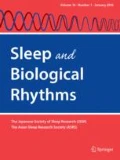Restless legs syndrome (RLS) is a sensorimotor neurological disorder that causes insomnia due to abnormal leg sensations. Migraine, characterized by moderate to severe headache, nausea and hypersensitivity to visual, auditory and olfactory stimuli, is a common neurovascular disorder associated with the major cause of disability worldwide [1]. A significant relationship between RLS and migraine has been confirmed by a systematic review and meta-analysis [2]. Coexistent sleep disturbances can exacerbate migraine headaches, whereas good sleep relieves headaches. A prospective study showed that RLS had a significant impact on headache-related disability in patients with migraine [3], highlighting the importance of managing sleep disorders, including RLS, in patients with migraine. Impairments in dopamine and iron metabolism as well as common genetic factors have been suggested as shared pathophysiologies for both diseases [2, 4].
In a meta-analysis of resting-state functional magnetic resonance imaging (MRI) studies, compared with healthy controls, patients with RLS had decreased functional connectivity within the dopaminergic network, including the nigrostriatal, mesolimbic, and mesocortical pathways, and increased functional connectivity in sensory thalamic circuits, including the ventral lateral, ventral anterior, ventral posterior lateral, and pulvinar thalamic nuclei [5]. These results support deficits in controlling and managing sensory information and dopaminergic dysfunction in RLS. It has been hypothesized that in RLS, reductions in iron content in the basal ganglia and thalamus lead to dysfunction of mesolimbic and nigrostriatal dopaminergic pathways and, in turn, to a dysregulation of limbic and sensorimotor networks [6].
A case–control diffusion tensor imaging (DTI) study showed that no microstructural white matter changes were observed in middle-aged chronic and episodic migraineurs compared to age- and sex-matched healthy subjects [7]. In comparison with healthy controls, patients with migraine without aura had significantly altered DTI-derived metrics within the hypothalamus [8]. A functional MRI study showed altered connectivity in the amygdala, which receives intense dopaminergic innervation from the midbrain, in patients with migraine without aura compared with matched healthy controls [9]. Furthermore, recent brain imaging studies suggested abnormalities in the interictal period of migraine patients, which may be related to sensory hypersensitivity in patients with migraine.
However, there have been no functional brain imaging studies of patients with comorbid migraine and RLS. Gurkan et al. [10] first investigated microstructural changes in the basal ganglia in migraine patients with and without RLS using DTI. The authors found that the values of fractional anisotropy, a DTI-derived metric assessing directional homogeneity of water diffusion, in the left putamen differed between migraine patients with RLS and without RLS. In addition, RLS and frequency of migraine attacks were factors related to the left putamen fractional anisotropy values based on a multiple regression analysis. These results suggested alterations in the microstructure of the basal ganglia in patients with comorbid RLS and migraine. The changes in the basal ganglia in patients with migraine and RLS in the study by Gurkan et al. [10] include important findings for elucidating the shared pathophysiology of migraine and RLS. However, their study did not assess the severity of RLS and excluded patients using dopamine agonists, indicating that it may have included patients with mild forms of RLS. Large sample studies using neuroimaging techniques of patients with migraine and RLS are warranted to evaluate microstructural brain changes in these patients.
References
Ashina M, Katsarava Z, Do TP, Buse DC, Pozo-Rosich P, Ozge A, et al. Migraine: epidemiology and systems of care. Lancet. 2021;397(10283):1485–95.
Wang J, Gao Y, Liu L, Xu W, Zhang P, Liu Y, et al. The association between migraine and restless legs syndrome: an updated systematic review and meta-analysis. Sleep Med. 2019;57:21–9.
Suzuki K, Suzuki S, Haruyama Y, Kobashi G, Shiina T, Hirata K. Restless legs syndrome is associated with headache-related disabilities in patients with migraine: a prospective 7-year follow-up study. Eur J Neurol. 2019;26(2):238–45.
Schurks M, Winter A, Berger K, Kurth T. Migraine and restless legs syndrome: a systematic review. Cephalalgia. 2014;34(10):777–94.
Kocar TD, Muller HP, Kassubek J. Differential functional connectivity in thalamic and dopaminergic pathways in restless legs syndrome: a meta-analysis. Ther Adv Neurol Disord. 2020;13:1756286420941670.
Rizzo G, Li X, Galantucci S, Filippi M, Cho YW. Brain imaging and networks in restless legs syndrome. Sleep Med. 2017;31:39–48.
Neeb L, Bastian K, Villringer K, Gits HC, Israel H, Reuter U, et al. No microstructural white matter alterations in chronic and episodic migraineurs: a case-control diffusion tensor magnetic resonance imaging study. Headache. 2015;55(2):241–51.
Porcaro C, Di Renzo A, Tinelli E, Di Lorenzo G, Seri S, Di Lorenzo C, et al. Hypothalamic structural integrity and temporal complexity of cortical information processing at rest in migraine without aura patients between attacks. Sci Rep. 2021;11(1):18701.
Huang X, Zhang D, Wang P, Mao C, Miao Z, Liu C, et al. Altered amygdala effective connectivity in migraine without aura: evidence from resting-state fMRI with Granger causality analysis. J Headache Pain. 2021;22(1):25.
Gurkan ZM, Pak AT, Dogan SN, Sengul Y (2022) Microstructural changes of basal ganglia in migraine with restless legs syndrome: findings from a neuroimaging study. Sleep Biol Rhythms. https://doi.org/10.1007/s41105-022-00376-7
Author information
Authors and Affiliations
Corresponding author
Additional information
Publisher's Note
Springer Nature remains neutral with regard to jurisdictional claims in published maps and institutional affiliations.
Rights and permissions
About this article
Cite this article
Suzuki, K. Microstructural changes in the basal ganglia in restless legs syndrome and migraine. Sleep Biol. Rhythms 20, 323–324 (2022). https://doi.org/10.1007/s41105-022-00393-6
Published:
Issue Date:
DOI: https://doi.org/10.1007/s41105-022-00393-6

